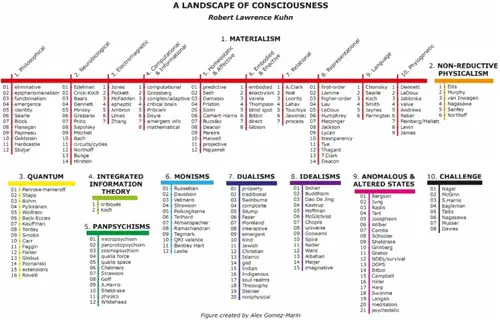|
TRANSLATE THIS ARTICLE
Integral World: Exploring Theories of Everything
An independent forum for a critical discussion of the integral philosophy of Ken Wilber
  Frank Visser, graduated as a psychologist of culture and religion, founded IntegralWorld in 1997. He worked as production manager for various publishing houses and as service manager for various internet companies and lives in Amsterdam. Books: Ken Wilber: Thought as Passion (SUNY, 2003), and The Corona Conspiracy: Combatting Disinformation about the Coronavirus (Kindle, 2020). Frank Visser, graduated as a psychologist of culture and religion, founded IntegralWorld in 1997. He worked as production manager for various publishing houses and as service manager for various internet companies and lives in Amsterdam. Books: Ken Wilber: Thought as Passion (SUNY, 2003), and The Corona Conspiracy: Combatting Disinformation about the Coronavirus (Kindle, 2020).
Check out my other conversations with ChatGPT Does Wilber Merely Restate the Mind-Body Problem?Frank Visser / Grok
 The mind-body problem—how subjective consciousness emerges from or interacts with physical processes—has long perplexed philosophers and scientists. In A Landscape of Consciousness: Toward a Taxonomy of Explanations and Implications, Robert Lawrence Kuhn maps over 200 theories addressing this enigma, reframing it as a multidimensional “landscape of consciousness.”[1] Among these, Ken Wilber's Integral Theory, detailed in section 17.6, stands out with its bold claim that a rational solution is impossible, proposing instead that trans-rational contemplation dissolves the problem. Yet, a critical question lingers: does Wilber merely restate the mind-body problem in a more elaborate, holistic guise, or does his approach offer a genuine transcendence? This essay explores Kuhn's overview of the field, then assesses Wilber's proposal, focusing on its trans-rational dissolution, integrative strengths, and limitations—particularly its lack of mechanistic specificity. For Integral World readers, Wilber's vision invites both admiration and scrutiny as we navigate this timeless debate. Overview of the Field: Kuhn's Landscape of ConsciousnessKuhn traces the mind-body problem to Descartes' 17th-century dualism, which separates mind and body, sparking the challenge of their interaction. This was later refined by David Chalmers' “hard problem”: why do physical processes yield subjective qualia (e.g., the experience of red)? Kuhn expands this into a “landscape of consciousness,” encompassing phenomenal experience, access consciousness (information processing), and self-consciousness. He critiques reductionist neuroscience for neglecting metaphysics and introduces a three-dimensional taxonomy to classify theories:
This yields ~20 hybrid positions, reflecting the field's diversity. Key theories include:
Kuhn charts the field's history from Aristotle's hylomorphism to Descartes, through physicalism's 20th-century dominance and Chalmers' post-1990s revival of dualism/panpsychism, with Eastern non-dualism influencing modern thought, including Wilber's. He concludes that pluralism, integrating empirical and metaphysical views, navigates this landscape effectively.

A Landscape of Consciousness (Click to enlarge)
Assessing Wilber's Integral Theory: Restatement or Dissolution?In section 17.6, Kuhn presents Wilber's Integral Theory as a meta-framework via the All Quadrants, All Levels (AQAL) model, integrating subjective (I), objective (It), cultural (We), and systemic (Its) dimensions of consciousness. Wilber, drawing from Sex, Ecology, Spirituality (1995) and Integral Spirituality (2006), argues that the mind-body problem arises from “flatland” thinking—overemphasizing one quadrant—and evolves through developmental levels (archaic to nondual). [Central to his proposal is the assertion that a rational solution is impossible due to dualistic cognition, with trans-rational contemplation dissolving the problem by revealing a unified Kosmos[2]. FV] The AQAL Framework and Trans-Rational ApproachWilber's AQAL model maps consciousness holarchically (wholes within wholes):
Consciousness develops through levels (e.g., rational to transpersonal), lines, states, and types. Wilber contends that rational stages (e.g., “orange” or “green”) create the mind-body problem by splitting subject and object, asking “how do neurons produce qualia?”—a question he deems unanswerable within dualism. Trans-rational contemplation, accessed via meditation or mystical practice at higher stages (e.g., “turquoise” or nondual), collapses this divide. In nondual awareness, mind and body co-arise as one reality—e.g., a meditative state (I) and EEG changes (It) are experienced as unified, shaped by culture (We) and society (Its), dissolving the need for a causal bridge. Taxonomic PlacementKuhn places Wilber's theory in the “Anomalous and Altered States” category:
Strengths
Criticisms
The Restatement DebateDoes Wilber restate the problem? His avoidance of mechanistic “how” questions—e.g., how qualia emerge—might suggest he restates it holistically, sidestepping Chalmers' hard problem. Critics argue this shifts it to a subjective, untestable realm. Yet, Wilber's intent is to dissolve it: the problem is an artifact of rational dualism, unresolvable by analysis but transcended through nondual awareness. This paradigm shift, while lacking empirical rigor (unlike Global Workspace Theory), redefines the debate, aligning with pluralism. Assessment and ConclusionKuhn's landscape reveals a field where physicalism leads empirically, dualism and panpsychism excel ontologically, but none fully resolve the mind-body problem. Wilber's Integral Theory offers a meta-solution, dissolving the problem via trans-rational contemplation. Its integrative and developmental strengths enrich the field, resonating with Integral World readers who value spiritual and holistic insights. However, its mechanistic gap and untestable claims limit scientific traction, fueling the restatement critique. Wilber's vision—transcending rational puzzles for a Kosmic unity—invites us to evolve beyond the problem's framing, a bold step forward if paired with empirical grounding. This debate echoes an earlier exchange with philosopher Christian de Quincey, who, in his review of Integral Psychology (2000), criticized Wilber's lack of mechanistic specificity as a flaw that restates the mind-body problem rather than resolving it. Wilber voiced his frustration that he is consistently misunderstood—his trans-rational, nondual approach intentionally transcends mechanistic demands, which he sees as a limitation of dualistic thinking.[3] This clash underscores the tension between Wilber's paradigm shift and the scientific demand for causal clarity, leaving readers to ponder whether his dissolution is a breakthrough or a sidestep, a question that continues to animate Integral World's discourse.
NOTES[1] Robert Lawrence Kuhn, "A landscape of consciousness: Toward a taxonomy of explanations and implications", Progress in Biophysics and Molecular Biology, Volume 190, August 2024, Pages 28-169. [2] Ken Wilber, Integral Psychology: Consciousness, Spirit, Psychology, Therapy, chapter 14, "The 1-2-3 of Consciousness Studies", pp. 174-187. [3] Frank Visser, "What's It Like to Be a Super-Nova? Ken Wilber's Cosmic Approach to the Mind-Body Problem", www.integralworld.net, May 2017.
Comment Form is loading comments...
|